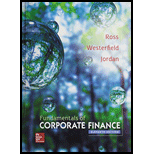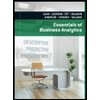
a)
To find: Whether there is an arbitrage opportunity and if so how can it be exploited.
Introduction:
The price of a country’s currency in terms of another nation’s currency is called exchange rate. The rate of exchange can be either floating or fixed. The two components of the exchange rates are the foreign currency and the domestic currency. The practice of taking advantage of a price that varies between two or more countries is an arbitrage.
b)
To find: The six-month forward rate to prevent arbitrage.
Introduction:
The price of a country’s currency in terms of another nation’s currency is called exchange rate. The rate of exchange can be either floating or fixed. The two components of the exchange rates are the foreign currency and the domestic currency. The practice of taking advantage of a price that varies between two or more countries is an arbitrage.
Want to see the full answer?
Check out a sample textbook solution
Chapter 21 Solutions
Fundamentals of Corporate Finance with Connect Access Card
- 8. Consider countries X and Y with risk-free rates of 8 and 10 percent, respectively. The future price (Currency X/ Currency Y) for a contract deliverable in 3 months is the same as the current exchange rate. Is there any arbitrage opportunity? If there is, design a strategy to exploit the arbitragearrow_forwardP19–1 EXCHANGE RATE MOVEMENTS Suppose a basket of goods in Paris costs €133and the same basket purchased in New York costs $153. At what exchange rate between euros and dollars is the cost of the basket of goods the same in each city? Now suppose that over the next year inflation in France is expected to be 2% while in the U.S. the forecast is for 6% inflation. What exchange rate do you expect a year from today?arrow_forward1. A one-year Japanese security is currently yielding 5%. Furthermore, it is expected that the exchange rate between the dollar and the yen is changing from 98 yen to the dollar, to 95 yen to the dollar over the next year. To invest in U.S. security rather than Japanese security, you would need a return at least equal to what value?arrow_forward
- QUESTION 1Everything else equal, the Phillips-curve in a country will shift upwards when the unemployment rate fallsthe central bank cuts interest ratesoil prices risethe government reduces tax rates on labour QUESTION 2Consider a country with a flexible exchange rate. If the central bank of this country raises its interest rate by 0.5%-points, whereas observers had anticipated an increase of only 0.25%-points, one can expect that: Bond prices and stock prices rise, the country’s currency depreciatesBond prices rise, stock prices fall, the country’s currency appreciatesBond prices fall, stock prices rise, the country’s currency depreciatesBond prices and stock prices fall, the country’s currency appreciates QUESTION 3We asked five students to give us three possible sources of an increase of the monetary base in the economy. Only one of the students came up with a completely correct list. This list included: an increase in central bank lending to banks, a purchase of…arrow_forwardAy 3. Suppose that in 2025, one- and two-year interest rates are 6.4% in the United States and 1.9% in Japan. The spot exchange rate is USD/JPY = 120.06. Suppose that one year later, interest rates are 3% in both countries, while the value of the yen has appreciated to USD/JPY = 114.80. A) Benjamin Pinkerton from New York invested in a U.S. two-year zero-coupon bond at the start of the period and sold it after one year. What was his return? B) Madame Butterfly from Nagasaki bought some dollars. She also invested in the two-year U.S. zero-coupon bond and sold it after one year. What was her return in yen? C) Suppose that Ms. Butterfly had correctly forecasted the price at which she sold her bond and that she hedged her investment against currency risk. What would have been her return in yen? Note: For all requirements, do not round intermediate calculations. Enter your answers as a percent rounded to 2 decimal places.arrow_forward22) The current exchange rate is 0.85 euros per dollar, but you believe the dollar will decline to 0.80 euros per dollar. If a euro-denominated bond is yielding 2%, what return do you expect in U.S. dollars?arrow_forward
- 29) Suppose that the two-year interest rates in Australia and the United States are 4.6% and 0.4% per annum, respectively, and the spot exchange rate between the Australian dollar (AUD) and the US dollar (USD) is 1.0500 USD per one unit of AUD. What is the theoretical forward exchange rate from the perspective of an Australian investor wanting to purchase USD in two years' time? A. 1.0134 AUD per USD. B. 1.0258 AUD per USD. C. 1.0234 AUD per USD..arrow_forward1. The exchange rate between the pound sterling and the dollar is currently $1.50 per pound, the dollar interest rate is 7% per year, and the pound interest rate is 9% per year. You have $100,000 in a one-year account that allows you to choose between either currency, and it pays the corresponding interest rate. a. If you expect the dollar/pound exchange rate to be $1.40 per pound a year from now and are indifferent to risk, which currency should you choose? b. What is the “break-even” value of the dollar/pound exchange rate one year from now?arrow_forward
 Essentials Of Business AnalyticsStatisticsISBN:9781285187273Author:Camm, Jeff.Publisher:Cengage Learning,
Essentials Of Business AnalyticsStatisticsISBN:9781285187273Author:Camm, Jeff.Publisher:Cengage Learning,

